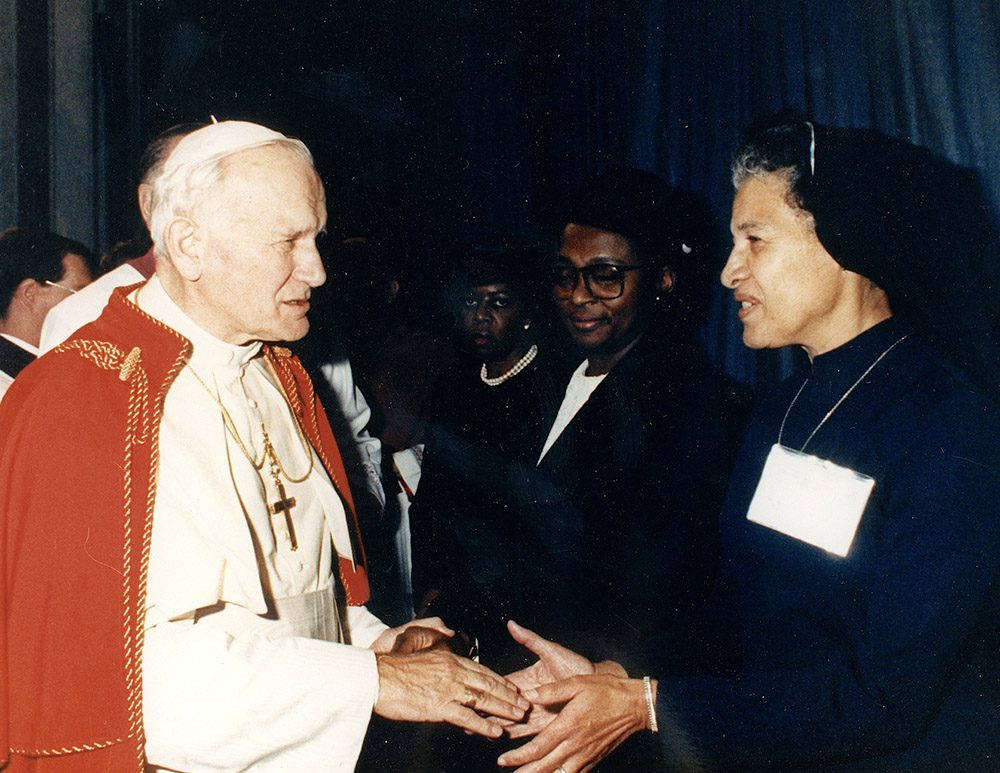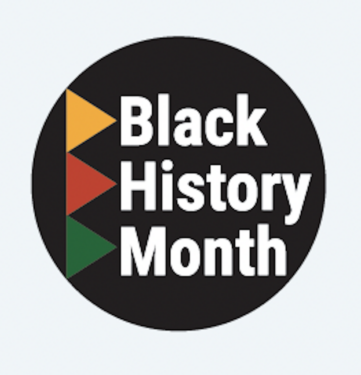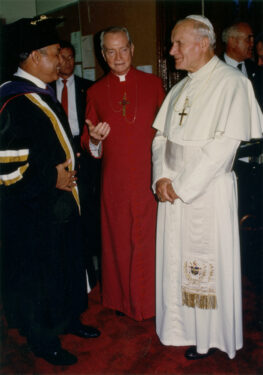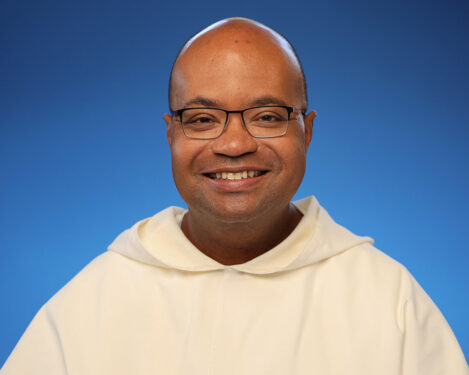
PROSPECT HEIGHTS — The national media converged on New Orleans Sept. 12, 1987, when Pope John Paul II — now a saint — became the first pontiff to visit the historic city at the edges of Louisiana’s bayous.
Reporters from large news organizations joined thousands of welcoming spectators for the pope’s whirlwind visit. Riding in the “popemobile” he darted throughout the “Big Easy” to complete multiple stops, including St. Louis Cathedral, the Louisiana Superdome, and Xavier University of Louisiana.
 Also known as XULA, the university is the only Catholic historically black college or university in the U.S. It was established in 1925 by St. Katharine Drexel.
Also known as XULA, the university is the only Catholic historically black college or university in the U.S. It was established in 1925 by St. Katharine Drexel.
Excitement especially flowed from black Catholics who were just hitting their strides in incorporating African American culture into the liturgy with lively gospel music and spirituals.
The Second Vatican Council had encouraged new forms of worship some 20 years earlier. Meanwhile, a new black Catholic spirit grew alongside victories in the civil rights movement.
Father Jeffery Ott was a junior at Xavier back then, and the editor of the college newspaper, the Xavier Herald. He also sang in the 50-member gospel choir during the pope’s stop at the university.
“I remember as a young person feeling part of the Church — really connected and joyful about serving,” Father Ott said. “And in my mind, Pope John Paul II was like a rock star.”
But Father Ott, pastor of Our Lady of Lourdes Parish in Atlanta, recently told The Tablet that many years passed before he fully realized the impact of the papal visit, and how it influenced his own story.
Still, the national media understood the significance and sent news crews to capture this historic moment. The pope — canonized in 2014 — went to the Superdome specifically to meet with the black Catholic community of New Orleans.
At the time, Auxiliary Bishop James Lyke (1939-1992) of Cleveland told the Los Angeles Times that this was the first time a pope had met with black Catholics as a body in the U.S.
“His visit will mean many things,” Bishop Lyke added. “But, above all, it certainly is going to dispel the myth that the Church is a white Church. That message should be loud and clear.”
And it was a message black Catholics had longed to hear. Their struggles were outlined in the same Times article by Father Fernand Cheri, then the 35-year-old pastor of St. Francis de Sales Parish in New Orleans.

He described how black Catholics had been treated like “second-class citizens” in local Catholic churches. He said they had to sit in back pews or choir lofts and had to wait until white parishioners received Communion before they could approach the altar.
“The miracle of the Church today is that we still have black Catholics after enduring what we have had to endure,” Father Cheri said in 1987. He went on to become an auxiliary bishop in New Orleans and served until his death last year.
Pope John Paul II told his Superdome audience that he empathized with black Catholics’ fight to shed the shackles of racial injustices.
“Even in this wealthy nation, committed by its Founding Fathers to the dignity and equality of all persons, the black community suffers a disproportionate share of economic deprivation,” Pope John Paul II said.
“Far too many of your young people,” he continued, “receive less than an equal opportunity for a quality education and for gainful employment.”
The pope said the Church must help to correct all imbalances and disorders of a social nature.
“Indeed,” he added, “the Church can never remain silent in the face of injustice, wherever it is clearly present.”
The pope went on to praise the civil rights movement. He called its nonviolent strategy for social justice a “monument of honor” to the black community of the U.S.
He mentioned the Rev. Martin Luther King Jr.’s providential role “in contributing to the rightful human betterment of black Americans and therefore to the improvement of American society itself.”
Father Ott said he did not remember which songs the gospel choir performed for the pope, but the pontiff was genuinely moved by the performance.
After his speech, he rushed over to the singers and greeted them with an exuberant affirmation in his thick Polish accent: “Choir! Choir! Choir!”
“We were just a bunch of screaming young people,” Father Ott said. “And he shook our hands — individually. It just blew my mind. I ran around for a good long time saying, ‘I shook the pope’s hand!’”

Still, the experience was like a seed planted that would remain dormant for several years because, at that time, Father Ott had no desire to be a priest.
He graduated from Xavier and moved to New York City to pursue a graduate degree in urban planning at Columbia University.
He wasn’t active in church until he heard about a parish on Dean Street in Brooklyn — Our Lady of Charity, which is now part of St. Matthew Parish in Crown Heights.
Father Ott had heard the services were lively with gospel-oriented music.
He recalled thinking, “Oh, I want to go to church there,” and so he did. He eventually moved from Harlem to Brooklyn to be closer to the parish.
Father Ott then recalled his interaction with the pope, and a seed of renewed spirituality sprouted. Soon he was pursuing a vocation with the Dominicans.
Now, as the pastor of an urban parish, he has a different appreciation of Pope John Paul II’s visit in 1987 and how it shaped his own future.
“All these years later,” Father Ott said, “it was an affirmation that my faith is important to me. And yeah, it made me excited about my walk with Jesus.”

Bishop Philip Hannan was an Army military Chaplain during WWII and served with the 82nd Airborne. He was very close to President Kennedy and his family and gave the homily at the President’s funeral Mass and later for Robert Kennedy and Jackie Kennedy Onasis.